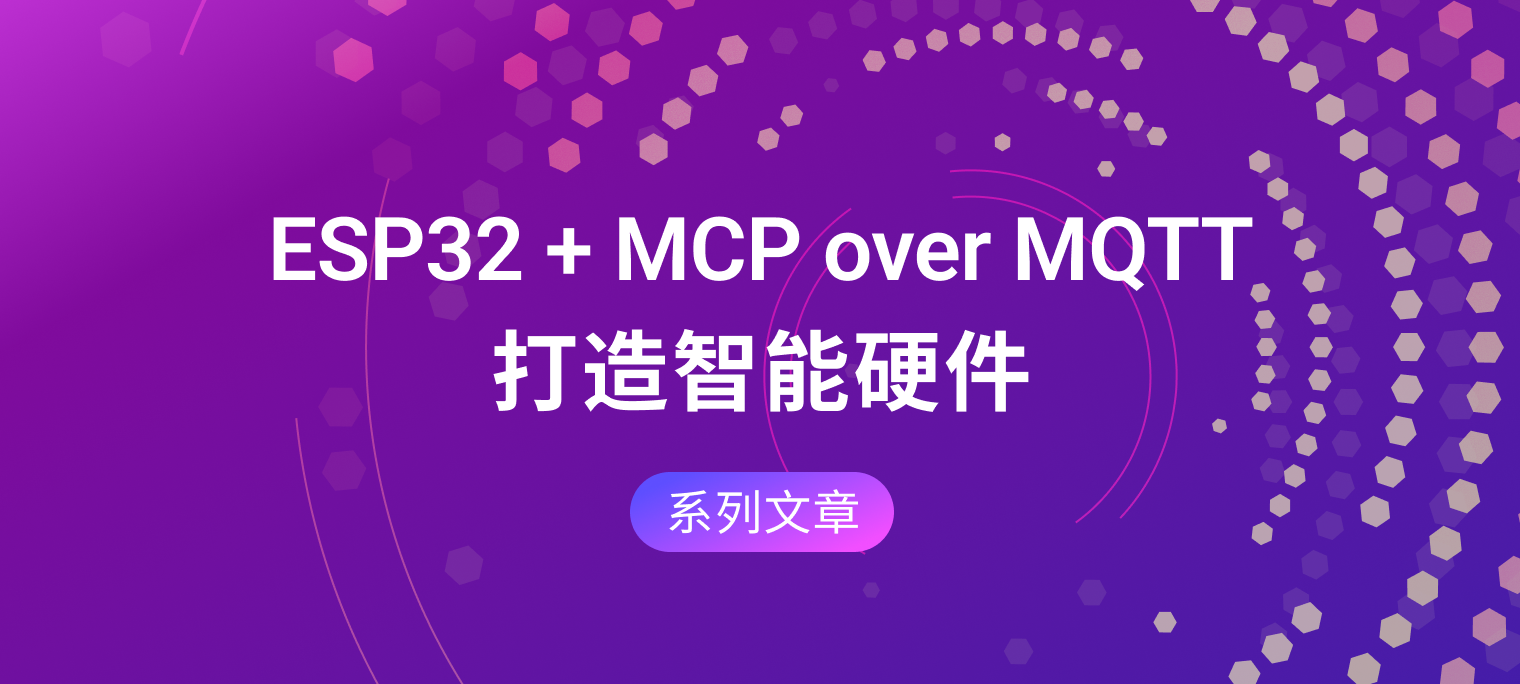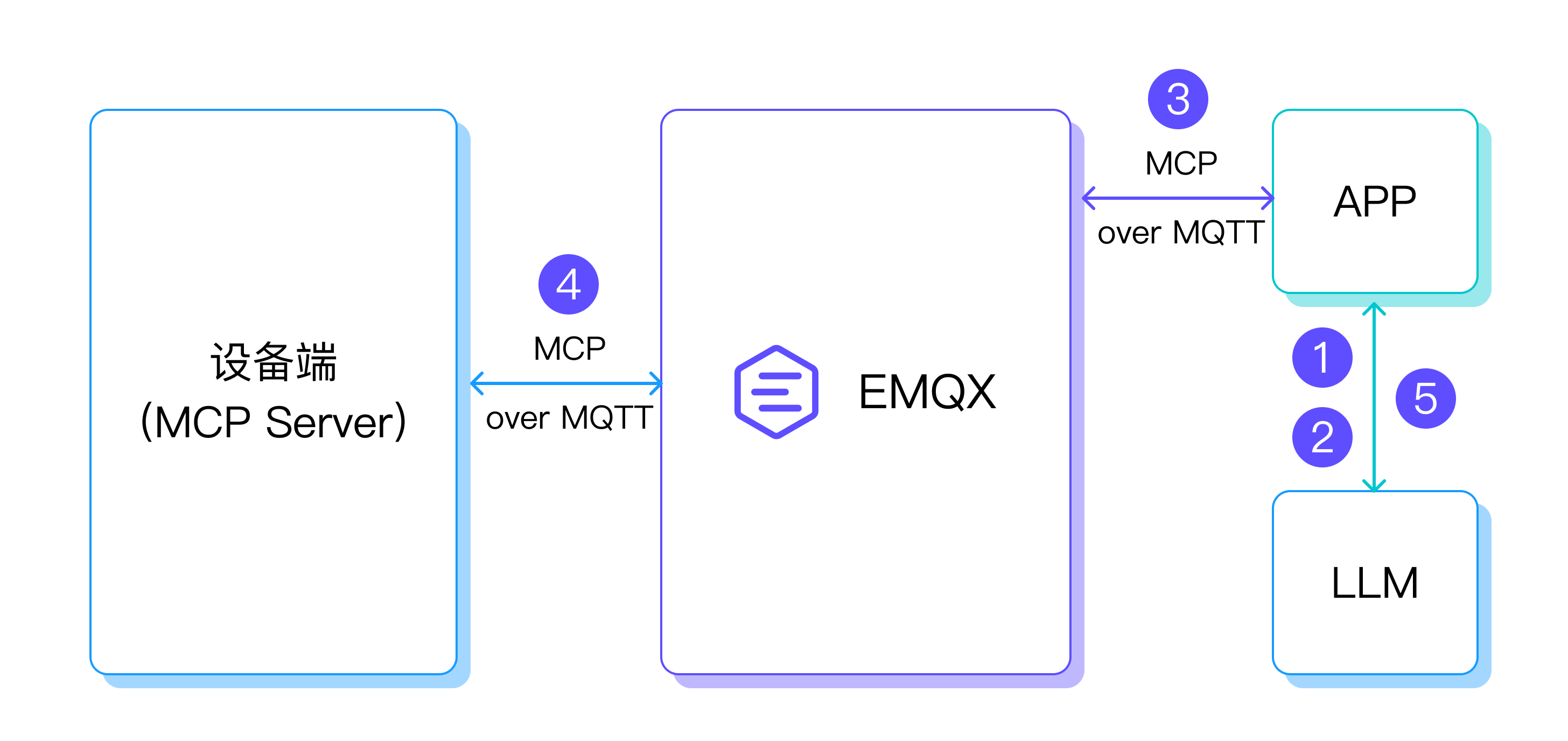本系列教程路线图
回顾:MCP over MQTT 封装设备能力
在上一篇文章中,我们介绍了如何使用 MCP over MQTT 协议,完成 ESP32 设备能力开发,并向 EMQX 注册与发现。
本篇将在此基础上,让大模型接管控制逻辑,实现「你说我做」的效果。
本篇目标:让大模型能「自然」地控制设备
本篇将介绍如何借助大语言模型(以下简称:LLM),实现通过自然语言对设备的控制。例如:
具体目标是:
为什么要接入大语言模型?
在 LLM 出现之前,设备控制主要依赖结构化输入:
即便语音识别结合 API 调用能实现部分「智能控制」,但一旦语句稍有偏差或接口发生变化,就容易“失灵”,造成用户挫败感。相比之下,LLM 天然具备语义理解与上下文保持能力,能带来:
更自然的交互方式;
更强的指令容错能力;
更低的开发和维护成本。
接入 LLM 后,设备控制的智能化能力大幅提升。它不仅能根据模糊语言推断对应函数调用,还能灵活应对不同厂商,以及硬件升级导致的接口变化,让设备的智能体验更加流畅丝滑。
程序执行过程
通过自然语言表达意图,LLM 负责理解语义。
将用户意图转化为结构化 MCP 工具调用(Tool Call), 并且提供合适的参数。
工具调用通过 MCP 协议被封装成标准的 MQTT 消息,经由 EMQX 转发到对应的 ESP32 设备。
ESP 执行具体的控制逻辑代码。
将工具的调用结果传给 LLM,由 LLM 给用户返回相关的调用结果,并由 APP 展示给用户。
整个链路简单直接,并且具备良好的解耦性和可扩展性,便于快速集成多种设备。
自然语言调用 MCP 工具
硬件
与上一篇文章所需硬件一致,无需调整。
软件
SiliconFlow API 密钥申请
ESP32 控制音量 MCP 服务
#include <math.h>#include <stdio.h>
#include "freertos/FreeRTOS.h"
#include "esp_log.h"#include "esp_system.h"#include "nvs_flash.h"
#include "mcp.h"#include "mcp_server.h"#include "radio.h"#include "wifi.h"
const char *set_volume(int n_args, property_t *args){ if (n_args < 1) { return "At least one argument is required"; }
if (args[0].type != PROPERTY_INTEGER) { return "Volume argument must be an integer"; }
int volume = (int) args[0].value.integer_value; if (volume < 0 || volume > 100) { return "Volume must be between 0 and 100"; }
esp_err_t ret = max98357_set_volume_percent((uint8_t) volume); if (ret != ESP_OK) { return "Failed to set volume"; }
ESP_LOGI("mcp server", "Setting volume to: %d%%", volume); return "Volume set successfully";}
void app_main(void){ esp_err_t ret = nvs_flash_init(); if (ret == ESP_ERR_NVS_NO_FREE_PAGES || ret == ESP_ERR_NVS_NEW_VERSION_FOUND) { ESP_ERROR_CHECK(nvs_flash_erase()); ret = nvs_flash_init(); } ESP_ERROR_CHECK(ret);
ret = max98357_init(); if (ret != ESP_OK) { ESP_LOGE("main", "MAX98357 init error: %s", esp_err_to_name(ret)); }
max98357_set_volume_percent(50);
wifi_station_init("wifi_ssid", "wifi_password");
vTaskDelay(pdMS_TO_TICKS(1000)); mcp_server_t *server = mcp_server_init( "ESP32 Demo Server", "A demo server for ESP32 using MCP over MQTT", "mqtt://broker.emqx.io", "esp32-demo-server-client", NULL, NULL, NULL);
mcp_tool_t tools[] = { { .name = "set_volume", .description = "Set the volume of the device, range 0 to 100", .property_count = 1, .properties = (property_t[]) { { .name = "volume", .description = "Volume level (0-100)", .type = PROPERTY_INTEGER, .value.integer_value = 50 }, }, .call = set_volume }, };
mcp_server_register_tool(server, sizeof(tools) / sizeof(mcp_tool_t), tools);
mcp_server_run(server);}
复制代码
使用 MCP Over MQTT Component 注册调整音量的 Tool,初始化 MCP Server 与 音频播放模块,注意修改 MCP Server 的参数,连接到 Serverless,以及修改 WIFI 的 SSID 与 Password。更多详细代码请参考 ESP32 Demo。
云端 MCP Client 对接大模型调用 MCP 工具 - agent.py
import asyncioimport anyioimport loggingimport osfrom typing import List, Optional, Union, castfrom dataclasses import dataclass
import mcp.client.mqtt as mcp_mqttfrom mcp.shared.mqtt import configure_loggingimport mcp.types as types
from llama_index.llms.siliconflow import SiliconFlowfrom llama_index.core.llms import ChatMessage, MessageRolefrom llama_index.core.agent import AgentRunnerfrom llama_index.core.tools import BaseTool, FunctionToolfrom llama_index.core.settings import Settings
configure_logging(level="DEBUG")logger = logging.getLogger(__name__)
async def on_mcp_server_discovered(client: mcp_mqtt.MqttTransportClient, server_name): logger.info(f"Discovered {server_name}, connecting ...") await client.initialize_mcp_server(server_name)
async def on_mcp_connect(client, server_name, connect_result): capabilities = client.get_session(server_name).server_info.capabilities logger.info(f"Capabilities of {server_name}: {capabilities}") if capabilities.prompts: prompts = await client.list_prompts(server_name) logger.info(f"Prompts of {server_name}: {prompts}") if capabilities.resources: resources = await client.list_resources(server_name) logger.info(f"Resources of {server_name}: {resources}") resource_templates = await client.list_resource_templates(server_name) logger.info(f"Resources templates of {server_name}: {resource_templates}") if capabilities.tools: toolsResult = await client.list_tools(server_name) tools = toolsResult.tools logger.info(f"Tools of {server_name}: {tools}")
async def on_mcp_disconnect(client, server_name): logger.info(f"Disconnected from {server_name}")
client = Noneapi_key = "sk-***"
async def get_mcp_tools(mcp_client: mcp_mqtt.MqttTransportClient) -> List[BaseTool]: all_tools = [] try: try: tools_result = await mcp_client.list_tools("ESP32 Demo Server") if tools_result is False: return all_tools list_tools_result = cast(types.ListToolsResult, tools_result) tools = list_tools_result.tools for tool in tools: logger.info(f"tool: {tool.name} - {tool.description}") def create_mcp_tool_wrapper(client_ref, server_name, tool_name): async def mcp_tool_wrapper(**kwargs): try: result = await client_ref.call_tool(server_name, tool_name, kwargs) if result is False: return f"call {tool_name} failed" call_result = cast(types.CallToolResult, result) if hasattr(call_result, 'content') and call_result.content: content_parts = [] for content_item in call_result.content: if hasattr(content_item, 'type'): if content_item.type == 'text': text_content = cast(types.TextContent, content_item) content_parts.append(text_content.text) elif content_item.type == 'image': image_content = cast(types.ImageContent, content_item) content_parts.append(f"[image: {image_content.mimeType}]") elif content_item.type == 'resource': resource_content = cast(types.EmbeddedResource, content_item) content_parts.append(f"[resource: {resource_content.resource}]") else: content_parts.append(str(content_item)) else: content_parts.append(str(content_item)) result_text = '\n'.join(content_parts) if hasattr(call_result, 'isError') and call_result.isError: return f"tool return error: {result_text}" else: return result_text else: return str(call_result) except Exception as e: error_msg = f"call {tool_name} error: {e}" logger.error(error_msg) return error_msg return mcp_tool_wrapper wrapper_func = create_mcp_tool_wrapper(mcp_client, "ESP32 Demo Server", tool.name) try: llamaindex_tool = FunctionTool.from_defaults( fn=wrapper_func, name=f"mcp_{tool.name}", description=tool.description or f"MCP tool: {tool.name}", async_fn=wrapper_func ) all_tools.append(llamaindex_tool) logger.info(f"call tool success: mcp_{tool.name}") except Exception as e: logger.error(f"create tool {tool.name} error: {e}") except Exception as e: logger.error(f"Get tool list error: {e}") except Exception as e: logger.error(f"Get tool list error: {e}") return all_tools
class ConversationalAgent: def __init__(self, mcp_client: Optional[mcp_mqtt.MqttTransportClient] = None): self.llm = SiliconFlow(api_key=api_key, model="deepseek-ai/DeepSeek-R1", temperature=0.6, max_tokens=4000, timeout=180) Settings.llm = self.llm self.mcp_client = mcp_client self.tools = [] self.agent = AgentRunner.from_llm( llm=self.llm, tools=self.tools, verbose=True ) self.mcp_tools_loaded = False async def load_mcp_tools(self): if not self.mcp_tools_loaded and self.mcp_client: try: mcp_tools = await get_mcp_tools(self.mcp_client) if mcp_tools: self.tools.extend(mcp_tools) self.agent = AgentRunner.from_llm( llm=self.llm, tools=self.tools, verbose=True ) logger.info(f"load {len(mcp_tools)} tools") self.mcp_tools_loaded = True except Exception as e: logger.error(f"load tool error: {e}") async def chat(self, message: str) -> str: try: if not self.mcp_tools_loaded: await self.load_mcp_tools() logger.info(f"user input: {message}") user_message = ChatMessage(role=MessageRole.USER, content=message) response = await self.agent.achat(message) logger.info(f"Agent response: {response}") return str(response) except Exception as e: error_msg = f"error: {e}" logger.error(error_msg) return error_msg
async def main(): try: async with mcp_mqtt.MqttTransportClient( "test_client", auto_connect_to_mcp_server=True, on_mcp_server_discovered=on_mcp_server_discovered, on_mcp_connect=on_mcp_connect, on_mcp_disconnect=on_mcp_disconnect, mqtt_options=mcp_mqtt.MqttOptions( host="broker.emqx.io", ) ) as mcp_client: await mcp_client.start() await anyio.sleep(3) agent = ConversationalAgent(mcp_client) print("input 'exit' or 'quit' exit") print("input 'tools' show available tools") print("="*50) while True: try: user_input = input("\nuser: ").strip() if user_input.lower() in ['exit', 'quit']: break if user_input.lower() == 'tools': print(f"available tools: {len(agent.tools)}") for tool in agent.tools: tool_name = getattr(tool.metadata, 'name', str(tool)) tool_desc = getattr(tool.metadata, 'description', 'No description') print(f"- {tool_name}: {tool_desc}") continue if not user_input: continue response = await agent.chat(user_input) print(f"\nAgent: {response}") except KeyboardInterrupt: break except Exception as e: print(f"error: {e}") except Exception as e: print(f"agent init error: {e}")
if __name__ == "__main__": anyio.run(main)
复制代码
上述代码基于 MCP over MQTT Python SDK 实现。
首先,初始化 MCP Client 并连接到 MQTT Broker(请将其中的 Broker 地址替换为你申请的 EMQX Serverless 实例地址)。客户端会自动发现并连接到已注册的 MCP Server。
随后,代码将 MCP Server 中注册的工具封装为 LlamaIndex 可调用的函数接口,供 LLM 使用。同时,还实现了一个简易的对话示例,用于展示可用工具列表及 LLM 的推理与调用过程。
ESP32 程序运行和部署
# ESP32 程序编译以及烧录$ idf.py build & idf.flash# ESP32 监控设备输出$ idf.py monitor
# 运行 Agent 代码,使用 uv 运行$ uv run agent.py
复制代码
云端 MCP Client 展示可用 MCP 工具
# 运行 agent.py 后,先输入任意内容,触发 Agent 更新连接的 MCP Server 信息# 然后输入 tools 查看可用的 MCP Tools
2025-08-06 02:29:39,958 - Agent response: Hello! How can I assist you today?
Agent: Hello! How can I assist you today?
user: toolsavailable tools: 1- mcp_set_volume: Set the volume of the device, range 0 to 100
复制代码
如上述所示,查询到一个 Tool,在 ESP32 上提供的调整设备的音量的工具。
示例对话 1:模糊控制
用户:设备声音太小了 LLM:调用 set_volume(80)ESP32:音量已调高
Agent 端日志输出:Agent 识别到用户的意图,调用 set_volume 调整音量到 80。
user: 设备声音太小了2025-08-06 02:37:29,134 - user input: 设备声音太小了> Running step 0701ab58-6c7e-41be-8a2e-210eab9b870f. Step input: 设备声音太小了Thought: The current language of the user is Chinese. I need to use a tool to adjust device volume since they reported it's too low.Action: mcp_set_volumeAction Input: {'kwargs': AttributedDict([('volume', 80)])}2025-08-06 02:38:24,926 - Got msg from session for server_id: esp32-demo-server-client, msg: root=JSONRPCRequest(method='tools/call', params={'name': 'set_volume', 'arguments': {'kwargs': {'volume': 80}}}, jsonrpc='2.0', id=3)2025-08-06 02:38:25,076 - Received message on topic $mcp-rpc/4d75d589169a41849fb86b51953110e3/esp32-demo-server-client/ESP32 Demo Server: {"jsonrpc":"2.0","id":3,"result":{"content":[{"type":"text","text":"Volume set successfully"}]}}2025-08-06 02:38:25,079 - Sending msg to session for server_id: esp32-demo-server-client, msg: root=JSONRPCResponse(jsonrpc='2.0', id=3, result={'content': [{'type': 'text', 'text': 'Volume set successfully'}]})Observation: Volume set successfully> Running step 71688059-5007-4087-84e1-a98993000ff7. Step input: NoneThought: The user reported that the device sound is too low. I've successfully increased the volume to 80. Now I can respond directly in Chinese without further tools.Answer: 已成功将设备音量调整到80,请检查是否合适。如果还需要进一步调整,请随时告诉我!
复制代码
ESP32 端日志输出:ESP32 接收到 set_volume 的工具调用,并把音量调整为 80。
I (503477) mcp_server: MCP client initialized: 4d75d589169a41849fb86b51953110e3I (503487) mcp_server: MCP client initialized: 4d75d589169a41849fb86b51953110e3I (503747) mcp_server: tools/list request received from $mcp-rpc/4d75d589169a41849fb86b51953110e3/esp32-demo-server-client/ESP32 Demo ServerI (508897) mcp_server: tools/list request received from $mcp-rpc/4d75d589169a41849fb86b51953110e3/esp32-demo-server-client/ESP32 Demo ServerI (585187) mcp_server: tools/call request received from $mcp-rpc/4d75d589169a41849fb86b51953110e3/esp32-demo-server-client/ESP32 Demo ServerI (585187) MAX98357: Set volume to 80%, 0I (585197) mcp server: Setting volume to: 80%
复制代码
示例对话 2:多轮对话
为了支持“声音有点大”这类模糊指令,需要 LLM 保持对话上下文,设置正确的参数进行调整。
框架记住上次调整的音量是 80;
当前语义推导为调整 -15;
最终调用 set_volume(65)。
Agent 输出:Agent 识别到用户意图,调整音量为 65,并调用 set_volume 调整音量。
user: 声音有点大了2025-08-06 02:38:58,092 - user input: 声音有点大了> Running step be73cc62-e732-4209-8421-2bccdd09cd70. Step input: 声音有点大了Thought: The current language of the user is Chinese. I need to adjust the volume lower since the user mentioned it's a bit loud. I'll decrease it from the previous setting (80) to a more comfortable level.Action: mcp_set_volumeAction Input: {'kwargs': AttributedDict([('volume', 65)])}2025-08-06 02:39:40,075 - Got msg from session for server_id: esp32-demo-server-client, msg: root=JSONRPCRequest(method='tools/call', params={'name': 'set_volume', 'arguments': {'kwargs': {'volume': 65}}}, jsonrpc='2.0', id=4)2025-08-06 02:39:40,236 - Received message on topic $mcp-rpc/4d75d589169a41849fb86b51953110e3/esp32-demo-server-client/ESP32 Demo Server: {"jsonrpc":"2.0","id":4,"result":{"content":[{"type":"text","text":"Volume set successfully"}]}}2025-08-06 02:39:40,237 - Sending msg to session for server_id: esp32-demo-server-client, msg: root=JSONRPCResponse(jsonrpc='2.0', id=4, result={'content': [{'type': 'text', 'text': 'Volume set successfully'}]})Observation: Volume set successfully
复制代码
ESP32 端打印的日志内容:ESP32 设备接收到 set_volume 调用,并把音量调整为 65。
I (660347) mcp_server: tools/call request received from $mcp-rpc/4d75d589169a41849fb86b51953110e3/esp32-demo-server-client/ESP32 Demo ServerI (660357) MAX98357: Set volume to 65%, 0I (660357) mcp server: Setting volume to: 65%
复制代码
您也可以试试其他模糊的对话方式,充分了解一下 LLM 对于自然语言的理解,以及把语义理解转换为工具调用的能力。
恭喜你,完成了本次任务:使用 LLM 实现用自然语言对设备进行控制。
下篇预告
通过本篇内容,我们打通了自然语言控制的完整路径:LLM 理解并调用部署在 ESP32 设备上的 MCP 工具,MCP 将调用转为 MQTT 指令发送给硬件设备,智能设备响应并执行对应指令。
下一篇中,我们将为智能硬件设备引入语音能力,结合语音识别和语音合成等第三方服务,探索如何在 ESP32 中实现真正的自然语音对话。
资源










评论